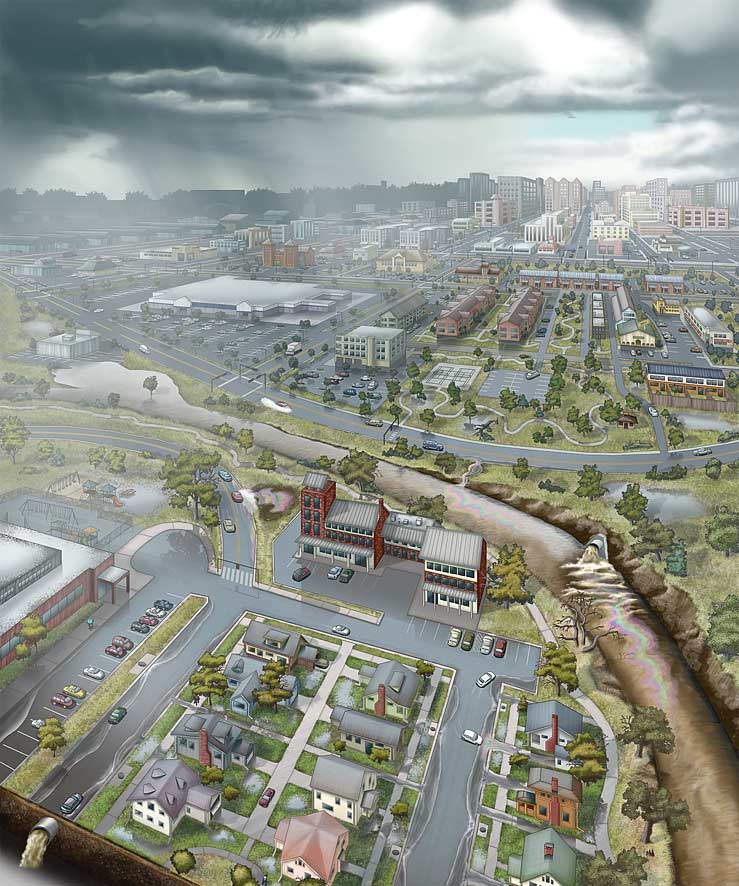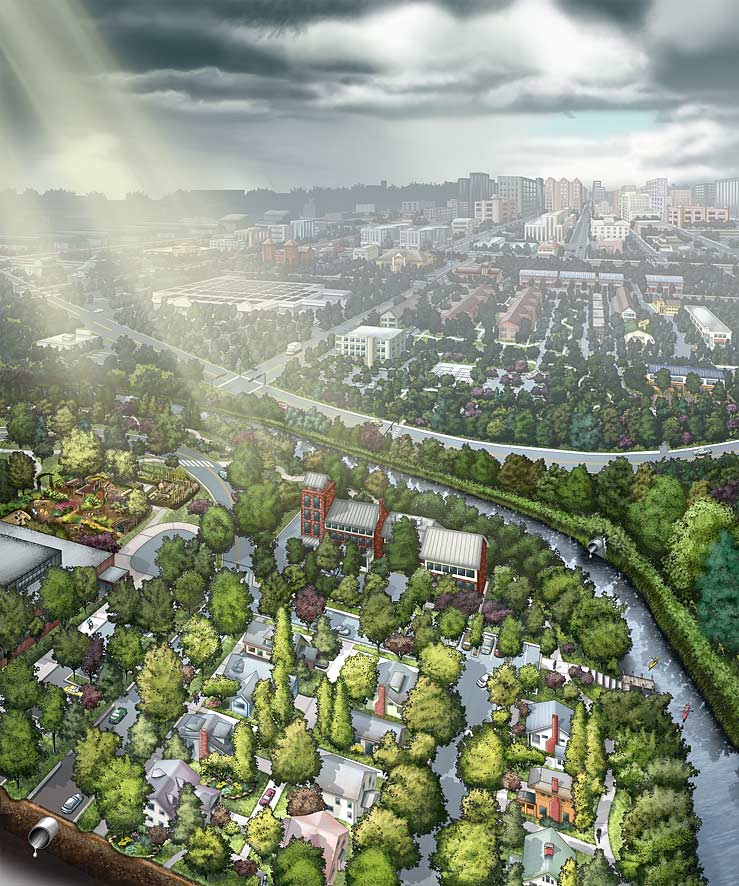Trees Tame Stormwater (Interactive Poster)
Drag the slider to fade between a water system with few trees, and one with abundant trees. Click on the numbers to see the changes that trees make for cities.


- 1
- 2
- 3
- 4
- 5
- 6
- 7
- 1. Treeless Parking Lots are unsightly, add to stormwater runoff and are a source of heat that is not only uncomfortable but increases air pollution. See how trees can help.
- 2. Treeless Streets deprive the community of social benefits and ecological services. Following storms, water rushes along the street sides. See how trees can help.
- 3. Asphalt Playgrounds are unnatural places for children to play, contributing to a disconnect with nature. The solid surface also prevents rain from slowly re-charging groundwater, instead adding extra volume to runoff. See how trees can help.
- 4. Treeless Homes and Yards reduce property values, increase energy costs and allow rainfall to rush into gutters. See how trees can help.
- 5. Erosion-prone Rivers eat away at adjoining property, destroy fish habitat and fill in reservoirs and waterways with silt. See how trees can help.
- 6. Compacted Lawns without trees are not only less appealing, they often can’t soak up heavy rains fast enough. Excessive runoff flows across sidewalks and down driveways and streets. See how trees can help.
- 7. Overwhelmed Sewage Systems can lead to untreated sewage being swept into waterways. Upgrades are expensive, adding to local tax burdens. See how trees can help.
- 1. Well-Landscaped Parking Lots can be designed to slow storm runoff and beautify the community. They cool parked cars, reducing evaporated gasoline that contributes to air-polluting ozone. Tree shade also adds longevity to paved surfaces. See what happens with fewer trees.
- 2. Tree-lined Streets retain large volumes of rainfall, reducing and cleansing runoff. They also increase property values, encourage shopping and business, reduce air pollution, calm traffic and lower noise levels. See what happens with fewer trees.
- 3. Nature Explore Classrooms at schools can be combined with nearby community gardens and natural areas to serve as neighborhood parks. Their unpaved surfaces increase rainwater retention as they provide nature-rich play and learning spaces for children. See what happens with fewer trees.
- 4. Shaded Homes and Tree-filled Yards make urban life more pleasant and provide practical benefits such as lower heating and air conditioning costs and increased re-sale values. The tree canopy is also a major contributor to stormwater runoff reduction. See what happens with fewer trees.
- 5. Riparian Buffers consisting of trees and shrubs along waterways slow flood waters, reduce erosion, cool the water for fish, and filter harmful runoff from adjoining land. See what happens with fewer trees.
- 6. Rain Gardens hold water onsite, reducing wasteful runoff and providing moisture for tree roots and flower beds. They also filter chemicals draining from walks, driveways and streets. See what happens with fewer trees.
- 7. Manageable Stormwater Runoff results from abundant trees, multi-use catch basins and rain gardens, reduced impervious surfaces, and increased ground vegetation. The benefits are lower costs and a more livable, sustainable environment. See what happens with fewer trees.
Rain refreshes the land and nourishes the green landscape. But as houses, stores, schools, roads and parking lots spread and natural tree cover is lost, so is the absorbing effect of vegetation and soil. The welcome rain becomes costly stormwater runoff. Without the benefit of trees and vegetated infrastructure, waterways are polluted as oils, heavy metal particles and other harmful substances are washed away. Fish and wildlife suffer, drinking water becomes expensive or impossible to reclaim, property values are reduced, and our living environment is degraded.
Download & Print This Poster
Download a PDF version of these posters in several sizes.
